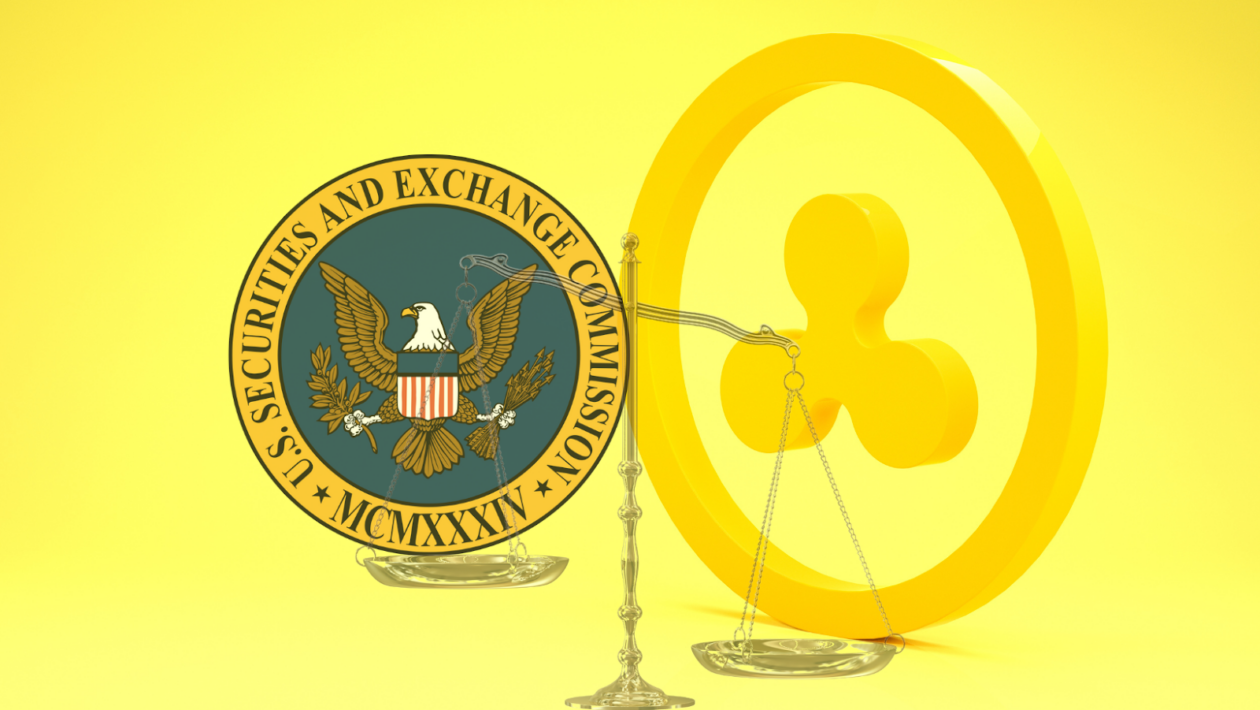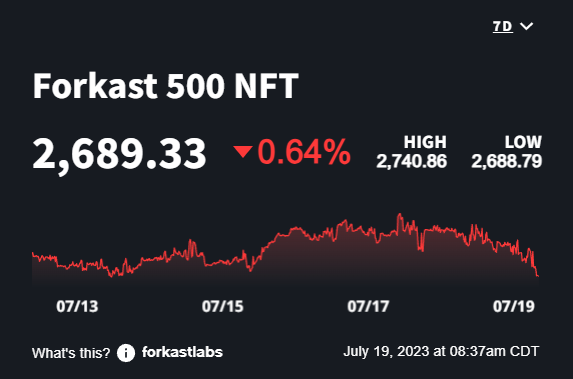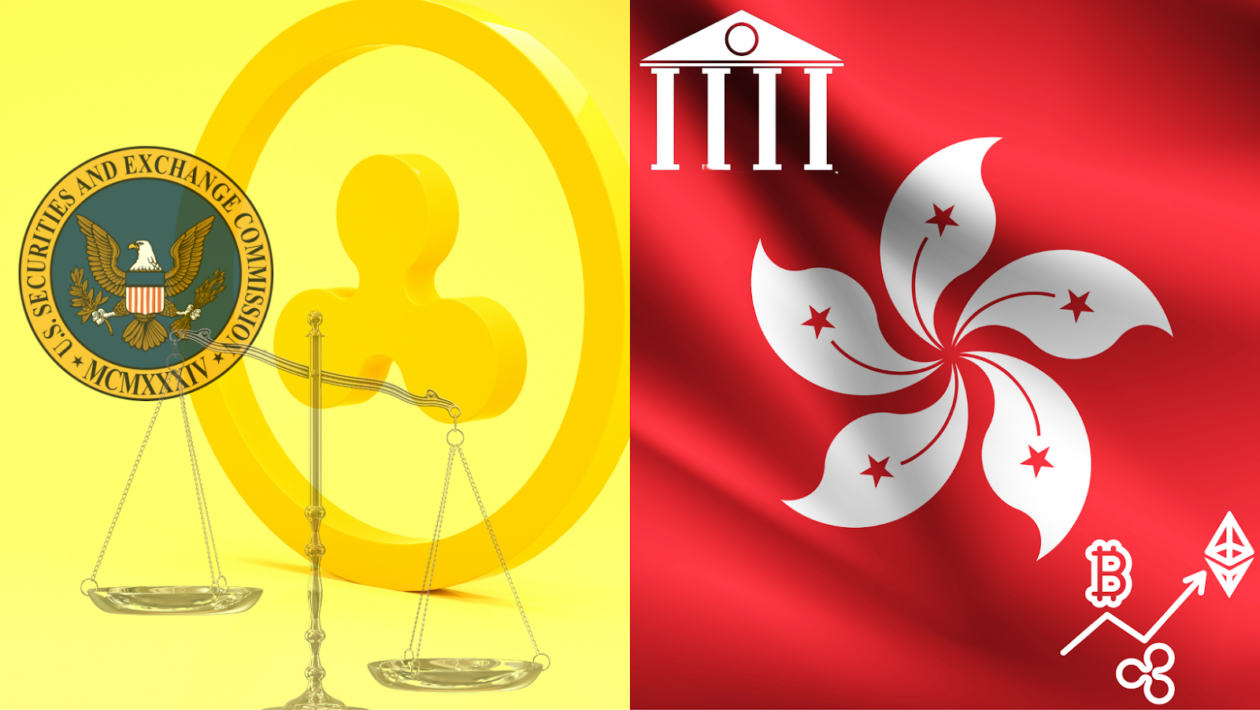In this issue
- Ripple Labs: More turbulence ahead?
- Forkast 500 NFT Index: Entering a historically slow period
- Hong Kong banks: Going back and forth
From the Editor’s Desk
Dear Reader,
The crypto community can be forgiven for feeling a little schadenfreude in recent days after we all watched a judge in the Southern District of New York stick it to the Securities and Exchange Commission in its case against Ripple Labs.
But, as many in the digital asset industry quickly began to realize when details of the verdict emerged, it was a little premature to pop the champagne, and the “payback time” mood was short-lived.
True, the SEC appears to have suffered a setback in its crusade to regulate (some might say crush) crypto by enforcement, and the Ripple-linked token XRP almost doubled in value on the news, with trading volumes briefly topping those of all other cryptocurrencies, but the victory was only partial. More importantly, it failed to provide the eureka moment of unambiguous regulatory clarity that the crypto industry and many other constituencies had hoped for.
The court’s ruling that XRP isn’t a security when it’s sold on exchanges and via algorithms, but that it is when it’s sold to institutional buyers, is an unhappy compromise that, while potentially providing relief to the likes of Cardano and Solana, also targeted by the SEC, remains underwhelming.
Its most egregious failure is that it leaves the door open for further legal interpretations. That could mean more muddying of the already turbid legal waters. It could also mean an appeal of the court’s decision by the SEC when the regulator has finished licking its wounds.
Ripple’s win can therefore be described as limited, and it begs the question of why we’re not seeing such unproductive – and indeed destructive – legal wars of attrition in other jurisdictions.
Could it be because many – notably the European Union – have come up with workable regulatory frameworks for the industry rather than blowing hot and cold on it as U.S. politicians have done while the SEC fills the policy vacuum with lawsuits?
When it comes to regulation, the U.S. has often been at the forefront of innovation, and its frameworks of rules and norms have been emulated the world over. Given that, and the fact that crypto is such an intensely innovative phenomenon, we can and should expect better.
Until the next time,
Angie Lau,
Founder and Editor-in-Chief
Forkast.News
1. Think twice

In a Tuesday letter to SEC Chair Gary Gensler, a U.S. lawmaker urged the financial regulator to “reassess its regulatory assault on crypto assets” after the verdict on the Ripple-SEC case last week.
- “In a landmark legal opinion, Judge Torres resoundingly rejected the regulatory overreach of the SEC, which has been indiscriminately declaring all crypto assets, except Bitcoin, to be securities,” said Representative Ritchie Torres of New York in the letter posted on Twitter, adding that “(crypto) regulation by enforcement had a dreadful day in court.”
- Torres commented after U.S. District Court Judge Analisa Torres ruled on July 13 that Ripple Labs’ programmatic sales of its XRP cryptocurrency did not qualify as financial securities, marking a partial victory for Ripple in its almost three-year lawsuit against SEC, which accused the former of conducting unregistered securities offering. However, the summary judgment also ruled that Ripple’s direct sales of XRP to institutional clients violated the securities law.
- At a Monday event of the National Press Club in Washington, D.C., Gensler said he was “disappointed” with the court’s ruling regarding the retail investors, and his agency was still assessing the judge’s opinion.
- Boosted by the court ruling, the XRP price has surged over 68% since July 13 and rose past US$0.70 for the first time since April 2022, according to data from CoinMarketCap. The token traded at US$0.81 at press time.
- “The ruling is a big win for the industry overall, offering clarity to the status of digital assets,” Jeff Mei, chief operating officer of crypto exchange BTSE, said in an emailed comment on July 14. “Although the ruling decision was based on the specific details of the Ripple case, the results will definitely support other firms who are in legal battles with the SEC regarding the classification of their products in the U.S.”
- Despite the general optimism in the crypto industry, some advised caution as regulatory uncertainty persisted. “There will be further court proceedings … It is also not yet known if the SEC will appeal the ruling,” Caroline Bowler, chief executive officer of Australia-based crypto exchange BTC Markets, told Forkast in an email. “Potential for more insecurity ahead for Ripple.”
Forkast.Insights | What does it mean?
In a landmark court decision with implications for the global cryptocurrency industry, the verdict concerning the status of XRP has been met with both clarity and confusion by stakeholders.
For retail investors of XRP who participated in the secondary sales of the digital currency, such as those that acquired it through crypto exchanges, this legal outcome brought much-needed clarity. CoinMarketCap data indicates a noteworthy surge in the asset’s value to US$0.82, a peak not seen since pre-Terra-Luna in April 2022, which was observed shortly following the court’s decision.
The potential future ramifications of this ruling for the classification of cryptocurrencies as securities in the U.S. cannot be overstated. Lawsuits recently lodged by the SEC against Binance and Coinbase underscored this, with the agency deeming at least 12 additional cryptocurrencies, including popular coins like Cardano’s ADA and Solana’s SOL, as securities. Should the recent ruling concerning secondary XRP sales extend to these cryptocurrencies, investors may find further cause for celebration. Some leading exchanges in the U.S. that delisted XRP have already started to relist the cryptocurrency.
Nevertheless, a cautious approach remains warranted. While some commentators have hastened to label the recent XRP ruling as a significant triumph for cryptocurrency investors, only a fraction of XRP transactions since 2017, less than 1% as court documents suggest, qualify as programmatic sales.
Notably, the court concluded that Ripple’s direct XRP sales to professional investors infringed U.S. securities laws. Despite the ruling being largely perceived as a victory for the sector, safety might only extend to 1% of XRP holders.
This leaves Ripple Labs and its executives, including Brad Garlinghouse and Chris Larsen, potentially entangled in continued legal complexities.
2. Who turned down the volume?

The non-fungible tokens market fell to another new low this week, even after positive news from across the blockchain industry following a U.S. judge’s ruling that XRP was not a security. Global NFT volumes fell to a seven-month low, with the Forkast 500 NFT Index slipping 0.64% to 2,689.33, reflecting the slow trading week.
- Blockchain sales volume shows Ethereum increasing 6.63%, Polygon rising 11.05%, and ImmutableX gaining 5.8%, while Bitcoin declined 54.96% and Solana lost 21.25%.
- Global NFT sales volume shrank to a 39-week low, the lowest since October 10-16, 2022.
- NFT weekly trade profits strengthened 66.5%, while average sales prices declined 5.41%.
- Daily Ethereum and Solana transactions on July 16 neared a two-year low, with 13,992 total transactions on Ethereum, the lowest since the blockchain’s 13,560 transactions on July 24, 2021. Solana had 10,475 transactions, its lowest since 8,462 transactions on Sept. 19, 2021.
- The Solana and Cardano Composites gained 4.63% and 5.38%, respectively, boosted by the increase in their platform’s token, $SOL (+18.9%) and $ADA (+8.11%).
- The Polygon Composite declined 5.37%, with the number of unique sellers falling 50% and total transactions decreasing 12.02%.
Forkast.Insights | What does it mean?
This week, the market slowed significantly on Sunday when Ethereum and Solana, the number one and three-ranked blockchains by sales volume, fell to nearly a two-year low in transactions. Global sales also declined to a 39-week low, showing investors have throttled back from trading. And who can blame them? Trade profits are still largely negative with US$8.2 million of losses for the week ending July 16, and new mints still are failing to offer innovation for collectors.
On any given day this week, CryptoSlam’s collections ranking perfectly shows the change in the market, with the top 10 leaderboard reflecting collections that struggle to reach US$500,000 in sales in a 24-hour period. Simply put, traders have stepped on the brakes as they slow down their trading practices and have moved onto securing grails, trading crypto, or taking a break entirely.
Prices of collections like Bored Ape Yacht Club, CryptoPunks, and Azuki continue to hover around two-year laws, but they’re full of NFTs that many consider grails. These low prices attract collectors who have been waiting to enter the exclusive communities and investors who still see great financial opportunities in these collections. Noteworthy sales this week include BAYC #1734 (US$1.2 million), CryptoPunks #8531 (US$1 million), CryptoPunks #5402 (US$340,000), CryptoPunks #512 (US$311,000), and around two dozen other CryptoPunks that sold for over US$100,000.
NFTs at the macro level show that the base of collectors in the NFT ecosystem has clearly grown over the years, even if they’re not as active now. Total transactions and supply in 2023 across blockchains dwarf what we have witnessed in years past. In fact, the increase in NFT supply, now up to some 302 million NFTs, shows the exponential growth that the blockchain collectibles ecosystem has witnessed since 2021, when fewer than 10 million NFTs existed. Total transactions in 2023 tell the same story, with over 44 million transactions just over halfway this year compared to 40 million last year, and 12.4 million in 2021.
With the NFT market heading into the historically slow August-December with little momentum behind it, NFTs seems to be falling headfirst into one of its first significant tests of traders’ conviction. This second-half stretch typically finds US collectors all but giving some NFTs for free as they look to harvest losses on their taxes. Will traders be spooked by the sale of grails at floor prices, along with volume and sales that may look closer to the period before NFTs reached the masses?
In some positive news to end this week, Yuga Labs announced that Ape Fest 2023 will take place on Nov. 3-5 in Hong Kong. With China potentially primed to enter the NFT market in a big way, traders are hoping the can’t-miss NFT party will help close out the year with NFT fireworks. Some even speculate that Yuga Labs may launch its Othereside metaverse to make this a worldwide party that bridges the physical and digital worlds. If they pull this off, the era of the metaverse may finally be upon us and with it, a potential new NFT boom.
3. Holding back

At least two global banks operating in Hong Kong have “ruled out any activity directly linked to crypto trading,” while others hesitate to open accounts for customers of crypto exchanges, the Wall Street Journal (WSJ) reported on Monday, citing anonymous sources, without naming the two banks.
- The banks’ reluctance to service crypto-related companies can be attributed to the money laundering risks in cryptocurrencies and a lack of risk-management frameworks in the crypto industry, according to the WSJ report.
- Local banks rejecting crypto companies could be an obstacle to Hong Kong’s economic ambition. Hong Kong aims to be a hub for the Web3 industry and in June, began its new licensing regime for virtual asset service providers.
- Hong Kong’s new licensing rules that require a crypto exchange to establish one or more segregated accounts with a financial institution, together with Hong Kong banks’ cautious attitudes, is an issue for crypto companies seeking to expand in the city.
- The banking issue has raised concerns among local regulators. In June, the Hong Kong Monetary Authority, the city’s central bank, reportedly pressed major lenders, including HSBC, Standard Chartered and Bank of China, to service local crypto exchanges, after issuing letters and commentaries to advise local banks not to reject crypto firms’ request to open accounts because of the industry.
- But not all lenders in Hong Kong are rejecting crypto companies. The WSJ report said an unnamed large global bank had changed its position and was considering opening basic accounts for crypto exchanges applying for licenses in Hong Kong, citing anonymous sources. Meanwhile, local banks such as ZA Bank and the Hong Kong branch of China’s Bank of Communications started servicing crypto firms earlier this year.
Forkast.Insights | What does it mean?
Not even two months following the day that Hong Kong’s cryptocurrency regulations came into effect, it seems that some people are already spoiling the party that many – perhaps especially the city’s government, which drafted them – had been eagerly anticipating.
The Journal’s report that two or more unnamed global banks in Hong Kong have eschewed engaging with anything linked to crypto trading inevitably invites speculation as to which lenders these might be.
The fact that HSBC, one of the city’s highest-profile banks, saw fit to beef up restrictions on its UK retail customers’ access to crypto assets earlier this year may suggest to some that it’s one of them. But given the limited information currently available, speculation would be imprudent.
More important than any witch hunt for names is the fact that – at least reportedly – big banks appear to be putting the brakes on the Hong Kong Monetary Authority’s ambitious plans to turn the city into a crypto hub. And, moreover, the fact that they appear to be doing so despite exhortations by the de facto central bank to service the industry it is so keen to nurture.
It’s apposite to recall that something similar occurred in India in 2020, when the country’s Supreme Court overturned a ban on banks’ handling of crypto-related transactions imposed by the Reserve Bank of India. Lenders listened more to the central bank than they did to the court, and proceeded to continue refusing crypto-linked business.
The specifics of the two cases differ, admittedly, but could we be seeing another case of banks simply not doing what they’re told?
A curious aspect of what’s happening in Hong Kong is the fact that Chinese state banks – once considered some of the least likely lenders in the world to touch anything with even a whiff of crypto, thanks to Beijing’s blanket ban on it – appear to have warmed to the idea of servicing crypto clients in the city. The extent to which they offer crypto businesses a way of going about their affairs in Hong Kong will be something to watch.
And given Hong Kong authorities’ increased willingness to assert their agenda following their Beijing-instigated assault on the local legal and political systems, the press and more during the past four years, we could even see other lenders receiving potentially more persuasive official encouragement to follow the state banks’ lead if they don’t toe the line.
But in the meantime, uncertainty complicates prospects for crypto enterprises trying to do business in a city where operating licenses depend on the ability to open accounts that banks are reluctant to make available.
As developers and entrepreneurs – like their counterparts in India a few years ago – weigh their options and consider more supportive financial ecosystems in which to operate, Hong Kong’s path to becoming a crypto hub seems more challenging than it ought to be.




